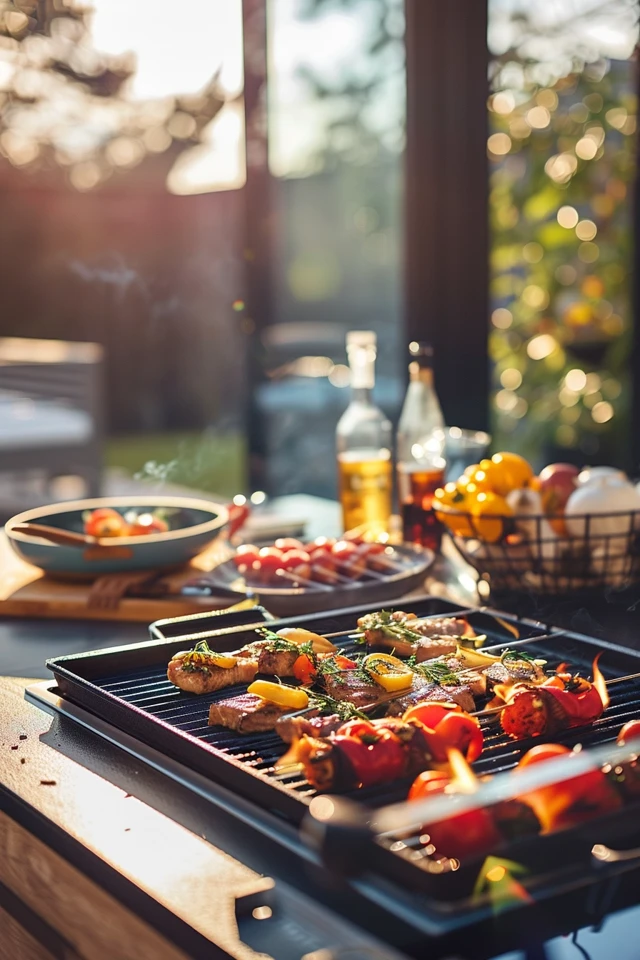Hello, fellow griddle enthusiasts! Are you tired of dealing with a rusty griddle and a compromised cooking surface? Well, fret not! In this guide, I will share with you some griddle maintenance hacks and rusty griddle cleaning tips to help you clean and restore your beloved cooking companion to its former glory.
When a griddle develops rust and starts looking worse for wear, it can be discouraging. However, with a few simple steps and the right techniques, you can easily bring your rusty griddle back to life. Not only will this improve its appearance, but it will also ensure that your food cooks evenly and deliciously once again.
So, let’s dive right in and explore the secrets to clean a rusty griddle and restore its cooking surface!
Key Takeaways:
- Learn how to clean a rusty griddle and restore its cooking surface.
- Follow griddle maintenance hacks and rusty griddle cleaning tips.
- Heating the griddle, scraping off rust, and using a grill stone or sandpaper are key steps.
- Proper seasoning and preventive measures can help prevent future rust.
- Regular cleaning, covering, and storing the griddle in a dry place are crucial for maintenance.

Steps to Clean a Rusty Griddle
To restore the cooking surface of a rusty griddle, follow these steps:
Heat up the griddle: Start by heating up the griddle to loosen any rust, food, or debris. This will make it easier to remove the buildup.
Scrape off rust and debris: Next, use a metal scraper or spatula to scrape off as much rust and debris as possible. Be thorough and make sure to remove all loose particles.
Clean with a grill stone or sandpaper: Use a grill stone or sandpaper to clean the griddle surface. Apply a bit of cooking oil to help remove rust and corrosion. The grit of the stone or sandpaper will help remove stubborn rust spots.
Wipe off remaining rust and debris: After cleaning, wipe the griddle surface with a cloth or paper towel to remove any remaining rust or debris. Make sure the surface is clean and free from residue.
Season the griddle: Finally, season the griddle to create a protective layer and prevent future rusting. Apply a thin layer of oil and heat the griddle until the oil starts to smoke. This will help to seal the surface and keep it well-protected.
By following these steps, you can effectively clean a rusty griddle and restore its cooking surface. Remember to always take proper maintenance measures to prevent rust and prolong the lifespan of your griddle.

Pro Tip: Regularly cleaning and seasoning your griddle after each use is key to maintaining its cooking surface. Additionally, covering it with a canvas cover and storing it in a dry place will help prevent rust formation.
Tips to Prevent Rust on Your Griddle
Preventing rust on your griddle is crucial for maintaining its cooking surface and ensuring optimal performance. Follow these easy tips to keep your griddle rust-free and extend its lifespan:
- Keep it clean: Regularly clean your griddle after each use to remove any food debris or grease buildup. Use a scraper or spatula to scrape off any residue, then wipe it down with a damp cloth or sponge.
- Season it right: Seasoning your griddle creates a protective layer that helps prevent rust. After cleaning, apply a small amount of cooking oil to the surface and spread it evenly with a paper towel. Heat the griddle for a few minutes to let the oil absorb, then let it cool before storing.
- Store it properly: When not in use, store your griddle in a dry place to prevent moisture buildup. Consider using a canvas cover to protect it from dust and humidity.
- Use a rust-resistant cover: If you live in a humid or coastal area, invest in a griddle cover made from rust-resistant materials like stainless steel or weatherproof fabric. This will provide an extra layer of protection against rust-causing elements.
- Avoid abrasive cleaners: Harsh chemicals or abrasive cleaners can damage the griddle’s surface and promote rust formation. Stick to mild dish soap and warm water for regular cleaning.
- Remove excess grease: Excess grease or oil can attract moisture and accelerate rusting. After cooking, drain any excess grease from the drip tray and wipe the surface clean.
- Check for any signs of rust: Regularly inspect your griddle for any signs of rust, especially in hard-to-reach areas and around the edges. If you spot any, address it immediately using the cleaning tips mentioned in Section 1.
Remember, prevention is key when it comes to rust on your griddle. By following these maintenance hacks and incorporating them into your routine, you can enjoy a rust-free griddle that delivers delicious, evenly cooked meals every time.
Now that you know how to prevent rust on your griddle, let’s move on to the concluding section and wrap up our comprehensive guide to cleaning rusty griddles.

Conclusion
Cleaning a rusty griddle and restoring its cooking surface is possible with the right tools and techniques. By following the steps outlined in this guide and implementing preventive measures, you can keep your griddle free from rust and enjoy flawless grilling.
Remember to regularly clean and season your griddle to create a protective layer that prevents rust and enhances cooking performance. By covering your griddle when not in use and storing it in a dry place, you can further safeguard it from moisture and corrosion. These griddle maintenance hacks will ensure that your cooking surface remains in excellent condition for many seasons to come.
So, roll up your sleeves, put on some elbow grease, and bring your rusty griddle back to life! With proper care and maintenance, you can enjoy delicious meals without worrying about rust or deterioration. Keep these rusty griddle cleaning tips in mind, and get ready to sizzle up a storm on your perfectly maintained griddle.

